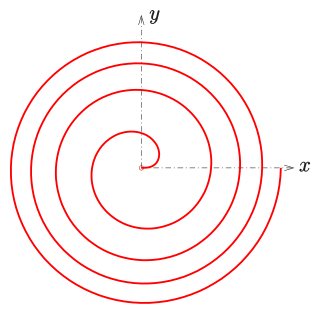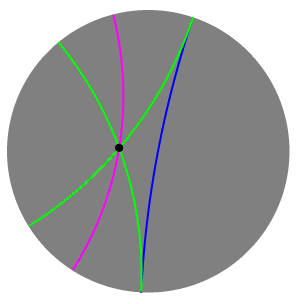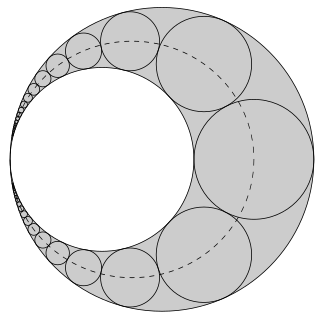
In geometry, the Schoch line is a line defined from an arbelos and named by Peter Woo after Thomas Schoch, who had studied it in conjunction with the Schoch circles.

In geometry, the Schoch line is a line defined from an arbelos and named by Peter Woo after Thomas Schoch, who had studied it in conjunction with the Schoch circles.
An arbelos is a shape bounded by three mutually-tangent semicircular arcs with collinear endpoints, with the two smaller arcs nested inside the larger one; let the endpoints of these three arcs be (in order along the line containing them) A, B, and C. Let K1 and K2 be two more arcs, centered at A and C, respectively, with radii AB and CB, so that these two arcs are tangent at B; let K3 be the largest of the three arcs of the arbelos. A circle, with the center A1, is then created tangent to the arcs K1, K2, and K3. This circle is congruent with Archimedes' twin circles, making it an Archimedean circle; it is one of the Schoch circles. The Schoch line is perpendicular to the line AC and passes through the point A1. It is also the location of the centers of infinitely many Archimedean circles, e.g. the Woo circles. [1]
If r = AB/AC, and AC = 1, then the radius of A1 is
and the center is

A circle is a shape consisting of all points in a plane that are at a given distance from a given point, the centre; equivalently it is the curve traced out by a point that moves in a plane so that its distance from a given point is constant. The distance between any point of the circle and the centre is called the radius. This article is about circles in Euclidean geometry, and, in particular, the Euclidean plane, except where otherwise noted.

In mathematics, an ellipse is a plane curve surrounding two focal points, such that for all points on the curve, the sum of the two distances to the focal points is a constant. As such, it generalizes a circle, which is the special type of ellipse in which the two focal points are the same. The elongation of an ellipse is measured by its eccentricity , a number ranging from to .

In mathematics, curvature is any of several strongly related concepts in geometry. Intuitively, the curvature is the amount by which a curve deviates from being a straight line, or a surface deviates from being a plane.

In geometry, the incircle or inscribed circle of a triangle is the largest circle contained in the triangle; it touches the three sides. The center of the incircle is a triangle center called the triangle's incenter.

A Fermat's spiral or parabolic spiral is a plane curve named after Pierre de Fermat. Its polar coordinate representation is given by

In geometry, Thales's theorem states that if A, B, and C are distinct points on a circle where the line AC is a diameter, the angle ABC is a right angle. Thales's theorem is a special case of the inscribed angle theorem and is mentioned and proved as part of the 31st proposition in the third book of Euclid's Elements. It is generally attributed to Thales of Miletus, but it is sometimes attributed to Pythagoras.
In geometry, the semiperimeter of a polygon is half its perimeter. Although it has such a simple derivation from the perimeter, the semiperimeter appears frequently enough in formulas for triangles and other figures that it is given a separate name. When the semiperimeter occurs as part of a formula, it is typically denoted by the letter s.

In geometry, an arbelos is a plane region bounded by three semicircles with three apexes such that each corner of each semicircle is shared with one of the others (connected), all on the same side of a straight line that contains their diameters.

In hyperbolic geometry, two lines may intersect, be ultraparallel, or be limiting parallel.

In geometry, the Beltrami–Klein model, also called the projective model, Klein disk model, and the Cayley–Klein model, is a model of hyperbolic geometry in which points are represented by the points in the interior of the unit disk and lines are represented by the chords, straight line segments with ideal endpoints on the boundary sphere.

A biarc is a smooth curve formed from two circular arcs. In order to make the biarc smooth, the two arcs should have the same tangent at the connecting point where they meet.

In geometry, the Pappus chain is a ring of circles between two tangent circles investigated by Pappus of Alexandria in the 3rd century AD.

In geometry, the Bankoff circle or Bankoff triplet circle is a certain Archimedean circle that can be constructed from an arbelos; an Archimedean circle is any circle with area equal to each of Archimedes' twin circles. The Bankoff circle was first constructed by Leon Bankoff in 1974.

In geometry, the twin circles are two special circles associated with an arbelos. An arbelos is determined by three collinear points A, B, and C, and is the curvilinear triangular region between the three semicircles that have AB, BC, and AC as their diameters. If the arbelos is partitioned into two smaller regions by a line segment through the middle point of A, B, and C, perpendicular to line ABC, then each of the two twin circles lies within one of these two regions, tangent to its two semicircular sides and to the splitting segment.

In geometry, Archimedes' quadruplets are four congruent circles associated with an arbelos. Introduced by Frank Power in the summer of 1998, each have the same area as Archimedes' twin circles, making them Archimedean circles.

In geometry, the Woo circles, introduced by Peter Y. Woo, are a set of infinitely many Archimedean circles.

In geometry, an Archimedean circle is any circle constructed from an arbelos that has the same radius as each of Archimedes' twin circles. If the arbelos is normed such that the diameter of its outer (largest) half circle has a length of 1 and r denotes the radiius of any of the inner half circles, then the radius ρ of such an Archimedean circle is given by
In geometry, the Schoch circles are twelve Archimedean circles constructed by Thomas Schoch.
In Euclidean plane geometry, a tangent line to a circle is a line that touches the circle at exactly one point, never entering the circle's interior. Tangent lines to circles form the subject of several theorems, and play an important role in many geometrical constructions and proofs. Since the tangent line to a circle at a point P is perpendicular to the radius to that point, theorems involving tangent lines often involve radial lines and orthogonal circles.

In Euclidean geometry, a bicentric quadrilateral is a convex quadrilateral that has both an incircle and a circumcircle. The radii and center of these circles are called inradius and circumradius, and incenter and circumcenter respectively. From the definition it follows that bicentric quadrilaterals have all the properties of both tangential quadrilaterals and cyclic quadrilaterals. Other names for these quadrilaterals are chord-tangent quadrilateral and inscribed and circumscribed quadrilateral. It has also rarely been called a double circle quadrilateral and double scribed quadrilateral.